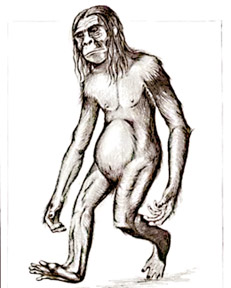|
Legend of the ‘Niya Atto’ Nittaewo:
Unearthing the Folklore
Amalshan GUNERATHNE
The dwarves, elves, goblins or midgets may it be, the stories and
legends which revolve around mythical creatures have always had the
capacity to fascinate, enthral and intrigue the human mind. As
spectacular though they may sound, sometimes you wonder whether there is
more to such stories than just myth and magic.
|

Dwarf nittaewo
looks like little wild man orang pendek from
nearby Sumatra |
The legends about creatures such as Big Foot and Yeti have aroused a
great sense of fascination that ultimately led to scientific studies
about these species. The fact is that no matter how sensational the
legends may be, they could still shed light on great mysteries about our
roots. Sadly though, not many meaningful scientific and archaeological
research has been conducted to unearth the roots of our own local legend
the ‘Nittaewo’.
However, the folklore about the local dwarfish race ‘Nittaewo’ is
fascinating study. The legends derive mainly from two sources. The first
source of study is the records of the British civil servant, Hugh
Neville which was drafted during 1886. The other source is the records
of the British Forest Officer Fredrick Lewis. Both were recorded after
gathering information from local villages and ‘Vaddas’. Lewis made his
records after his encounter with his Vadda guide Dissenhamy. It was
noted that Dissenhamy vividly narrated the legend of ‘Nittaewo’ to the
British official.
According to what was said by ‘Dissenhamy’ to Lewis, Nittaewo had
very powerful arms and strong hands which gave them the ability to tear
apart and disembowel anything they captured, within minutes. Dissenhamy
also said that they had nails like talons of an eagle. The very name
‘Nittaewo’ derives from the Sinhala term ‘niya aththo’ (the ones with
nails).
According to his tales, the Nittaewo surrounded their prey, if it was
a small animal, and beat it to death with stones. Then they tore open
its belly and drank its blood. Their language was very much similar to
the twittering of the birds. Their legs were hairy like that of monkeys.
The females were said to be shorter than the males and they lived in
caves, hollow trees and crevices.
Speaking to Daily News Punch Pradeep A Jayatunge, author of Nittaewo,
the Hobbits of Sri Lanka said, “Vaddas perceived them as savage
cannibals. Dissenhamy’s reports say, if they come upon a sleeping Vedda,
they fell on him and disembowelled him at once with their talons.
According to legend they were in competition with local Vaddas for the
same resources, ultimately becoming a nuisance to the Vaddas.
Consequently they chased Nittaewos with dogs, cornered them and trapped
them in their cave, piled firewood at the entrance and kept the fire
burning till they suffocated to death.”
However, what makes the ‘Nittaewo’ folklore so credible is that we do
not associate any supernatural element with their tales. “The unique
factor about Nittaewo tales is that the stories do not depict Nittaewos
as creatures that possess magical abilities. Nittaewo tales don’t have
the supernatural element, which makes it a very credible legend. The
other important factor is that the time of their extinction is
consistent in every tale,” Pradeep noted.

Pradeep A Jayatunge |

Sampath de Alwis
Goonatilake,
Programme Officer, IUCN |
Nonetheless, many speculations have been made as to the authenticity
of the legend. Some disregard the existence of ‘Nittaewo’ saying that
they were just a figment of imagination. Sampath de Alwis Goonatilake,
ICUN (International Union for Conservation of Nature) Programme Officer
noted, “Many speculations exist with regard to the Nittaewo legend. Some
believed that people mistook Sun bears (‘Rahu Valasa’) for Nittaewos.
Some suggest that it could just be some monkey species. But at the same
time there could be a possibility that they could be an isolated species
which evolved from Australopithecus or other humanoid species.”
Known writers such as R L Spittel have theorized that ‘Nittaewo’ were
nothing but a hairy bear species. Spittel was told by a young village
boy that Nittawaewos were shaggy-haired dwarfish creatures with long
nails that walked like men. Judging from such stories, perhaps Spittel
might have come to the conclusion that Nittaewo could either be brown
bears or sloth bears, mistaken for a humanoid species.
But disregarding Spittle’s view, Pradeep Jayatunge explained, “Even
when Hugh Neville conducted studies on Nittaewo, local villagers
characterized them as bear-like creatures covered in fur. But when he
inquired from Vaddas whether the Nittaewos had long hair, they were
amused. Vaddas told Neville that Sinhala locals have confused brown
bears with Nittaewo in making such assumptions. Vaddas knew how to
identify brown bears. Therefore Nittaewo has to be a different species
altogether.”
Regardless of the many speculations, no physical evidence has been
unearthed to prove their existence. Although many legends have been
circulating throughout the world about such species, many such tales are
yet to be proven by hardcore scientific and physical evidence. However,
the studies of such creatures took a positive change with the discovery
of Homo Florensiensis in Indonesian island Flores. The discoveries were
significant, because a legend about a humanoid creature called Ebu-Gogo
who resembled the same physical size as Homo-Florensiensis had
persevered for years in the region. Strangely though, the Indonesian
legend of Ebu-Gogo and Sri Lankan legend of Nittaewo have almost
identical storylines. The end of the both stories is almost identical.
Even in the Ebu-Gogo legend, they were said to have been exterminated by
locals after being trapped in a cave. “I find the similarities between
the two tales rather strange and fascinating,” says Pradeep.
However, without clear physical evidence, the tale of ‘Nittaewo’
would remain a mere fable. The lack of sources of study on the subject
is one of the major factors that threaten the legend. Almost all the
studies and assumptions on Nittaewo are based on what Neville and
Fedrick Lewis had to say. During the early 1960s, P Daraniyagala and
some others conducted archaeological studies in the area, but apart from
this not enough scientific studies have been done on the subject of
Nittaewos.
“We do not have a system where archaeologists go parallel with the
legendary tales and try to uncover the truth. Till physical evidence of
‘Troy’ was found, the city was just a fabled place in a piece of
literature. Those archaeologists followed the legend and unravelled the
truth.” Pradeep reiterated that it is the responsibility of our
anthropologists and archaeologists to do a proper research on the
subject of Nittaewo. “Even now, if we do a proper scientific,
archaeological excavation in the Panama area, we could unearth some
evidence, which would shed light on the Nittaewo story. I am not saying
that we will find hardcore evidence, but at least we can try.” |



